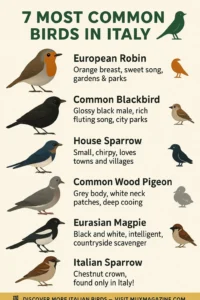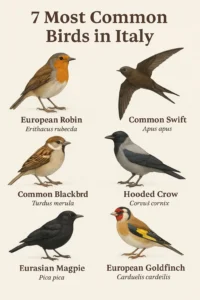Introduction: Discovering Italy’s Beautiful Birds
Italy, with its diverse landscapes—from the snowy Alps to the sun-drenched Mediterranean coasts—is a paradise for birdwatchers. Whether you’re strolling through historic cities, hiking in the countryside, or relaxing by a tranquil lake, you’re sure to encounter a rich tapestry of birdlife. In this guide, we’ll explore the 7 most common birds in Italy for nature lovers, diving deep into their behaviors, habitats, and how to spot them. If you’ve ever wondered what birds you’re seeing on your Italian adventures or you’re planning a birdwatching trip, this article will answer all your questions.
🐦 Birds to Spot in Italy

✅ European Robin (Pettirosso)
• Orange-red breast
• Found in gardens, parks, and forests• Year-round presence
✅ Common Blackbird (Merlo)
• Glossy black (male), brownish (female)
• Beautiful flute-like song
• Common in cities and rural areas
✅ House Sparrow (Passera Europea)
• Grey head, chestnut nape (male)
• Busy flocks in cities and countryside
• Cheerful chirping
✅ Barn Swallow (Rondine)
• Long forked tail
• Arrives in spring, leaves in autumn
• Graceful flight near fields and water
✅ Common Wood Pigeon (Colombaccio)
• Grey body, white neck patches
• Deep, rhythmic cooing sound
• Widespread in both cities and farmlands
✅ Eurasian Magpie (Gazza)
• Black and white plumage with green-blue sheen
• Highly intelligent, often scavenging
• Open countryside and gardens
✅ Italian Sparrow (Passera Italiana)
• Chestnut crown, white cheeks (male)
• Exclusive to Italy
• Common in southern towns and rural areas
7 Most Common Birds in Italy

1. European Robin (Erithacus rubecula)
What Makes the European Robin So Special?
The European Robin is arguably Italy’s most beloved bird. With its striking orange-red breast and melodious song, it holds a cherished place in Italian culture and folklore.
Where Can You Find Robins in Italy?
- Habitats: Gardens, parks, woodlands
- Regions: Nationwide, from north to south
- Behavior: Robins are territorial and are often seen perching boldly on low branches.
Fun Fact: In Italian, the robin is called Pettirosso, meaning “little red chest.”
How to Identify a European Robin
- Size: About 14 cm (5.5 inches)
- Color: Bright orange face and breast, brown upper parts
- Song: A sweet, wistful melody especially noticeable in early morning and dusk.
2. Common Blackbird (Turdus merula)
Why Are Blackbirds So Common in Italy?
The Common Blackbird adapts effortlessly to both rural and urban environments, making it one of Italy’s most familiar birds.
Typical Blackbird Habitats
- Habitats: Gardens, parks, forests, vineyards
- Regions: All across Italy, from city squares to remote forests.
How to Spot a Blackbird
- Male: Glossy black plumage, bright orange-yellow beak.
- Female: Brownish color with lighter speckles on the breast.
- Song: A rich, flute-like melody, often delivered from rooftops or treetops.
Tip: Look for blackbirds after a rain—they love searching for worms on wet ground!
3. House Sparrow (Passer domesticus)
The Ubiquitous Sparrow: A City Dweller’s Delight
House Sparrows are omnipresent across Italy. Their cheerful chirping fills city squares, countryside barns, and seaside villages alike.
Sparrow Habitat and Behavior
- Habitats: Urban centers, farms, suburban gardens
- Behavior: Highly social, often seen in flocks.
Identifying the House Sparrow
- Size: Small, about 16 cm (6.3 inches)
- Male: Grey head, black bib, chestnut brown nape
- Female: More subdued brown and grey tones
- Sound: A repetitive chirp that’s hard to miss.
Did you know? House Sparrows have coexisted with humans for over 10,000 years!
4. Barn Swallow (Hirundo rustica)
Barn Swallows: Italy’s Harbingers of Spring
The arrival of Barn Swallows heralds the beginning of spring in Italy. These aerial acrobats are a welcome sight after a long winter.
Where and When to See Swallows in Italy
- Migration: Arrive in March, depart in October.
- Habitats: Open fields, farms, near bodies of water.
How to Recognize a Barn Swallow
- Long forked tail (“streamers”)
- Metallic blue-black upper parts
- Creamy underparts with a hint of red on the throat
- Flight: Swift, graceful glides and sharp turns.
Local Saying: “Una rondine non fa primavera” — One swallow does not make a spring.
5. Common Wood Pigeon (Columba palumbus)
Why Wood Pigeons Thrive Across Italy
The Common Wood Pigeon is Italy’s largest pigeon species, easily distinguished from its city-dwelling cousins.
Wood Pigeon Habitat and Characteristics
- Habitats: Countryside, parks, urban gardens
- Regions: Predominantly northern and central Italy, but increasingly in the south.
Identifying Features
- Size: Up to 40 cm (15.7 inches)
- Color: Grey with a distinct white patch on the neck
- Call: A deep, rhythmic “coo-COO-coo-coo.”
Observation Tip: They often feed on grains, fruits, and seeds on the ground.
6. Eurasian Magpie (Pica pica)
Magpies: Intelligent and Mysterious
In Italy, Magpies are both admired and superstitiously feared. Known for their cleverness and glossy black-and-white feathers, these birds are easy to spot.
Habitat and Behavior of Magpies
- Habitats: Farmlands, parks, gardens, open countryside.
- Behavior: Curious, intelligent, and often seen scavenging.
How to Identify a Magpie
- Size: About 44-46 cm (17-18 inches)
- Color: Black and white body with iridescent green and purple gloss on wings and tail
- Call: A loud, chattering “chack-chack-chack.”
Cultural Note: In some Italian regions, spotting a magpie is considered a sign of luck—or mischief!
7. Italian Sparrow (Passer italiae)
Meet Italy’s Unique Sparrow
Exclusive to the Italian Peninsula, the Italian Sparrow is a charming bird species resulting from ancient hybridization.
Italian Sparrow Distribution
- Habitats: Towns, cities, open rural areas
- Regions: Predominantly central and southern Italy.
Identification Tips
- Male: Chestnut crown, white cheeks, grey underparts
- Female: Similar to House Sparrow but slightly lighter.
Conservation Note: The Italian Sparrow is a symbol of Italy’s rich biodiversity and is closely monitored for conservation purposes.
🧭 Birdwatching Tips:
- Best Time: Early mornings
- Best Seasons: Spring and Autumn
- Top Locations: Tuscany, Po Delta, Dolomites, Sardinia, Sicily
- Bring Along: Binoculars, bird field guide, notebook!
Conclusion: Embark on Your Italian Birdwatching Adventure!
Italy’s birdlife is as colorful and diverse as its culture. From the charismatic European Robin to the majestic Barn Swallow, the most common birds in Italy offer something for every nature lover. Whether you’re a seasoned ornithologist or a casual observer, birdwatching in Italy is an unforgettable experience.
➡️ Explore more articles like “How Does Zillow Rental Manager Work? Cost, Features & Overall Review (2025)”
Frequently Asked Questions (FAQs)
What are the most common birds in Italy?
- European Robin
- Common Blackbird
- House Sparrow
- Barn Swallow
- Common Wood Pigeon
- Eurasian Magpie
- Italian Sparrow
When is the best time for birdwatching in Italy?
- Spring (March-May): Migration season, most birds are active.
- Autumn (September-November): Ideal for watching migratory departures.
- Early mornings: Birds are most vocal and active.
Where can I go birdwatching in Italy?
- Tuscany: Rolling hills and vineyards
- Po Delta: Rich wetlands perfect for spotting herons and flamingoes
- Dolomites: Alpine birds like golden eagles
- Sardinia and Sicily: Unique island bird species










